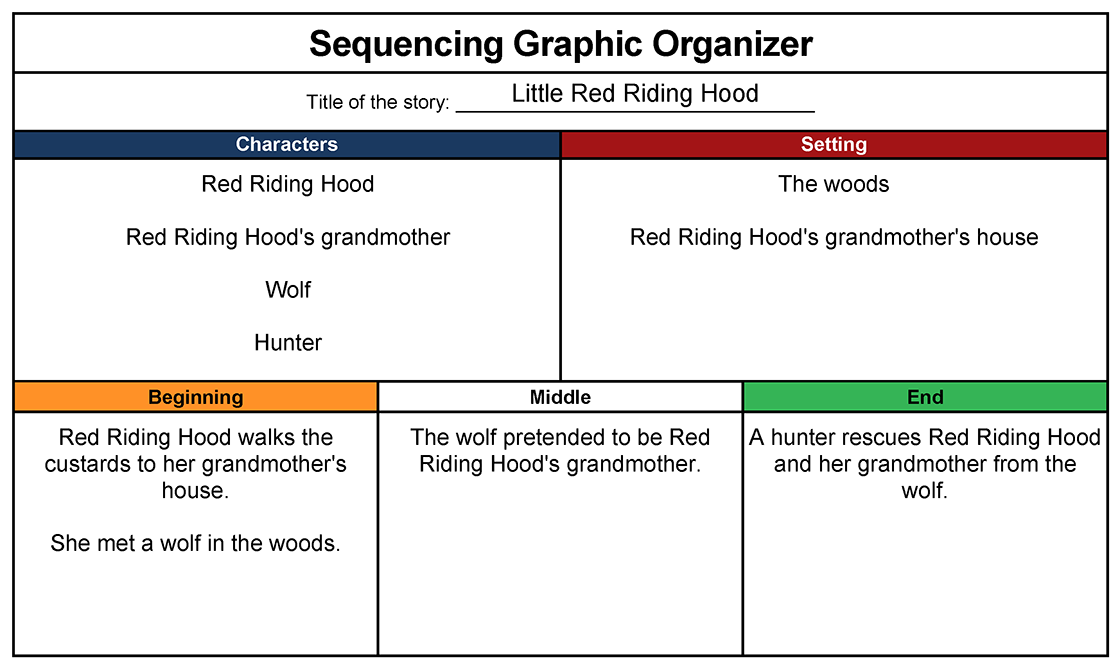Editor’s note: While learning at home, children can make progress toward grade-level reading and writing standards. This post is part of an ongoing series designed to help caregivers support children’s and teens’ literacy learning at home.
Children can demonstrate their listening and reading comprehension by retelling stories that they read or that are read to them (Hogan et al., 2011). When retelling a story, students should be able to identify the characters, settings, and sequence of events. Below are definitions of each element:
- Character: A person, animal, or thing in a story that takes action.
- Setting: The time and place of the story.
- Event: When one or more characters do something or take some sort of action in a setting.
- Sequence: The order of the events in the story (beginning, middle, and end).
Using a graphic organizer, such as the Sequencing Graphic Organizer used in this post (see Supplemental Materials for Families), can help children remember to look for and record the important elements of a story. This retelling activity is particularly beneficial for children enrolled in kindergarten through Grade 3, who are still learning to understand the elements of a story and how they work together to create meaning (Stadler & Ward, 2003). Initially you might select books that are easier for your children to grasp so that their attention can be devoted to learning how to identify the characters, settings, and events. As your children demonstrate an understanding of the story elements and how to record them on the graphic organizer, you can introduce more difficult books that have new ideas and vocabulary.
Children who are not yet able to read a book independently can watch and listen to an adult read or listen to recorded audio of the book being read. However, children who are able should read the book independently. You can have your children stop periodically while reading or listening to the story and discuss the characters, settings, and events. See our previous posts on Dialogic Reading and Caregiver Involvement for information about how to ask questions while reading a book.
As story elements are identified, have your child record them on the graphic organizer. Children can write or draw pictures that represent the characters, settings, and events that occur in the beginning, middle, and end of the story.
After completing the graphic organizer, ask your children to verbally retell the story. They can refer to the graphic organizer as a reminder of the story elements and the order in which the events occurred. If your children are able to write in complete sentences, you can have them practice retelling the story by writing a summary (Gilbert & Graham, 2010).
This sample Sequencing Graphic Organizer was completed on the story Little Red Riding Hood.

Versions of Little Red Riding Hood can be accessed through your public library in digital or paper form, are available to read online and in eBook form via Project Guttenberg, and are available in the following recordings on the web:
- Arabic
- Bengali
- Chinese
- Dutch
- English
- French
- German
- Greek
- Hindi
- Indonesian
- Italian
- Japanese
- Korean
- Portuguese
- Russian
- Sign Language
- Spanish
Supplemental Materials for Families
Children can use this graphic organizer for recording the characters, settings, and events of a story. This graphic organizer can be used to help your child identify the elements while reading or listening to a story.
References
Gilbert, J., & Graham, S. (2010). Teaching writing to elementary students in grades 4–6: A national survey. The Elementary School Journal, 110, 494–518. https://doi.org/10.1086/651193
Hogan, T., Bridges, M. S., Justice, L. M., & Cain, K. (2011). Increasing higher level language skills to improve reading comprehension. Focus on Exceptional Children, 44, 1–20. https://doi.org/10.3109/17549507.2014.904441
Stadler, M. A., & Ward, G. C. (2005). Supporting the narrative development of young children. Early Childhood Education Journal, 33, 73–80. https://doi.org/10.1007/s10643-005-0024-4
